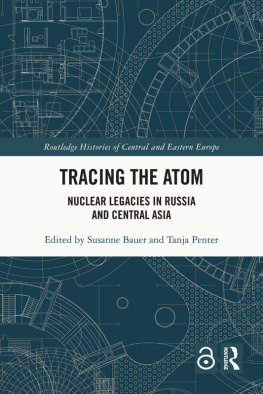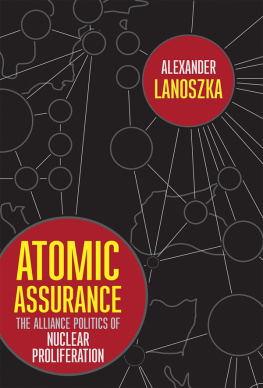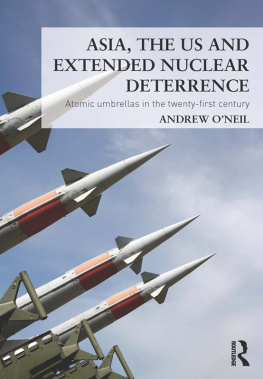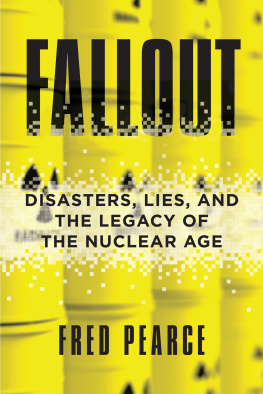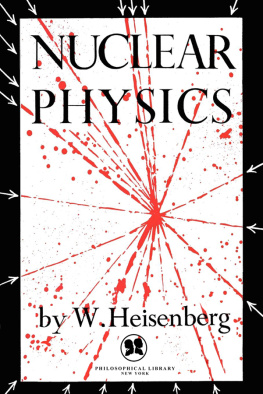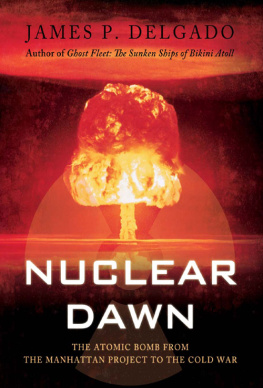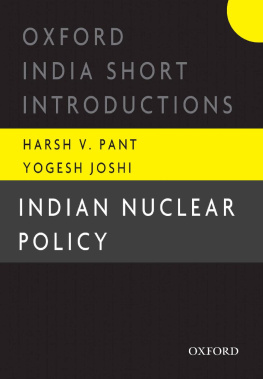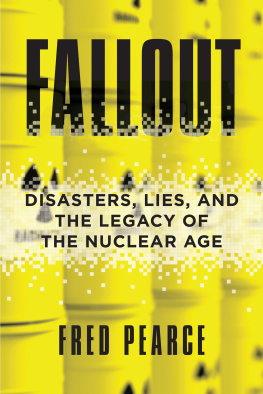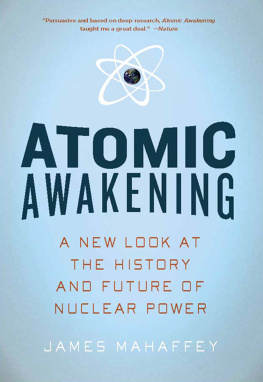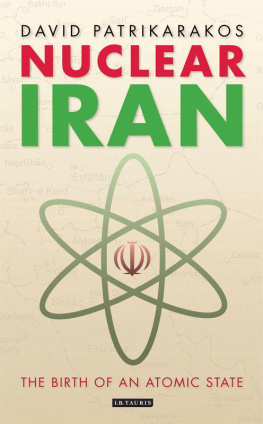Contents
- SUSANNE BAUER AND TANJA PENTER
- STEFAN GUTH
- LAURA SEMBRITZKI
- OLGA NIKONOVA
- SOPHIE ROCHE
- BETTINA KAIBACH
- TANJA PENTER
- EVA CASTRINGIUS
- SUSANNE BAUER
Introduction Tracing the Atom. Nuclear Legacies in Russia and Central Asia
Susanne Bauer and Tanja Penter
DOI: 10.4324/9781003246893-1
It was not just one nuclear power station that exploded, but that whole complex of irresponsibility, lack of discipline and bureaucracy, wrote the Belarusian writer Ales Adamovich in a letter to Mikhail Gorbachev in 1986.
In Ukraine and Belarus, the Chernobyl movement became an important part of the national movement. Representatives of the Ukrainian and Belarusian national movement even regarded the Soviet Chernobyl policy as genocide against their people. The uncovering of the Chernobyl disaster also encouraged revelations about previous nuclear accidents inside the Soviet Union: in the Chelyabinsk region of Russia, a public debate on the 1957 nuclear waste accident and its consequences became possible for the first time, and the environmental activists became part of a broader regionalist movement. In Semipalatinsk, Kazakhstan, a critical examination of the nuclear legacy of decades of atomic bomb tests began, which was also taken up by representatives of the movement for independence.
The change of concept from perestroika to catastroika, which goes back to the famous Russian dissident Alexander Zinovev, expressed the attitude toward life of many contemporaries who were overwhelmed by the increasing revelations about environmental disasters and the general problems of the transformational period. After the end of the Soviet Union, however, the environmental movements lost their social significance again in the second half of the 1990s, and attention to the problematic nuclear legacy of the Soviet era faded into the background in the face of other colossal transformational tasks. But the era of catastroika is far from over and there are many signs that the issue of how to deal with the nuclear legacies of the Soviet period will become one of the central issues of the twenty-first century.
This volume historicizes the legacies of nuclear weapons programs by focusing on the long-term consequences of nuclear programs, many of them tied to atomic weapons development. Their very epistemologies and material legacies have remained with us, even where disarmament and decommissioning have been more successful or were reintroduced. In terms of production infrastructures and nuclear supply chains, military and civil uses of nuclear power have been closely intertwined. Nuclear operations, for energy or military purposes, demanded a vast infrastructure of production and supply chains that have transformed entire regions. In foregrounding and following the material traces of the atomic programs, contributions in this volume pay particular attention to the memorialization of nuclear legacies and memory practices in a broader sense. We focus on the interrelations of legacies and transitions, sociotechnical imaginaries, memory practices, and heritage making in order to shed light on how modes of knowing intersect with livelihoods, politics of transitional justice and compensation, and historiography. Broadening the existing studies of nuclear history, this volume centers on radiation knowledge, institutional responses to nuclear legacies, and on how various communities, scientists, and artists articulated their concerns over nuclear issues. In what follows, we conceptualize an approach to studying the temporalities of the Cold War nuclear and discuss what the concepts of tracing, heritage, and legacies entail to this end. In following nuclear matters at different scales, chapters of this book examine the role of radiation expertise within specialized research institutes in Soviet and international settings as well as variegated modes of living with the political, legal, and epistemic endurances of the atom.
Nuclear Fission and the Supply Chains of the Soviet Atomic Programs
Nuclear operations, for energy or military purposes, have always demanded a vast technopolitical infrastructure of mining, processing, and handling of nuclear materials. The development of nuclear fission technologies goes back to the 1930s with the race for a nuclear weapon between the allied forces and Nazi Germany of the late 1930s and 1940s during World War II. Nazi Germany's nuclear program was pursued at the institutes of the Kaiser Wilhelm Gesellschaft in Berlin. In the United States, research into nuclear fission had begun to form in 1939, when the core agencies that led to the Manhattan Project were formed. Military researchers involved in the Manhattan Project conducted the first nuclear detonation in the Alamogordo desert in New Mexico on July 16, 1945, later known as the Trinity test. In Japan, however, there has been a strict separation of the promoted nuclear energy usage and anti-nuclear weapons stances by its government, which only after the 2011 Fukushima nuclear disaster had become connected in the public discourse and this connection became one of the key arguments of the protesters against nuclear energy in the wake of the Fukushima triple disaster.
During the Cold War, the extended production and supply chains have irreversibly transformed large areas, not least for their enduring material legacies, given the long half-lives of the radionuclides of technologies that cannot be contained in time. These massive infrastructures have operated within a deferred temporality the handling of nuclear waste was optimistically deferred to technoscientific futures that were expected to solve the issue. Along the entire nuclear supply chains, radiation expertise was needed and developed. At the beginning of the nuclear fuel cycle is uranium mining, which provides the materials that are needed for nuclear fission: Roche gives an ethnographic account of an understudied site of nuclear mining in Leninabad/Khujand (Tajikistan), which was one of the first smaller scale uranium mining sites in the USSR from the early 1940s. Especially the above-ground nuclear explosions between 1949 and 1965 deposited local and global fallout leading to persistent anthropogenic traces in the environment (Bauer).
With this volume we zoom in on the Soviet atomic programs during the Cold War and beyond, focusing on nuclear sites that are much less known, compared to the more broadly researched Chernobyl accident of 1986 or the Fukushima-Daiichi disaster of 2011. This book brings to the fore nuclear infrastructures, from uranium mining and the envisioned nuclear fuels cycle, as well as its visions to fuel socialist modernity and a military complex justified as a requirement for peacebuilding. In line with nuclear modernity's visions of energy abundance, the Soviet civil nuclear energy program launched a nuclear-powered model city of Shevchenko/Aktau in today's Republic of Kazakhstan (Guth). For four decades, the Soviet atomic weapons program conducted nuclear testing near Semipalatinsk/Semey in the eastern region of today's Kazakhstan (Bauer).
Indeed, the supply chain of nuclear projects in the USSR starts with uranium mining. In addition to Central Asian sites such as Leninabad/Khujand in Tajikistan and Mailuu Suu in Kyrgyzstan, the USSR obtained uranium from the Wismut sites in East Germany, and from Czechoslovakia and Bulgaria as early as 19491951, before the first nuclear reactor for energy opened in Obninsk (110 km south-west of Moscow) in 1954. Nuclear politics on both sides of the iron curtain can only be understood when attending to the infrastructures of the large-scale atomic technology programs during the Cold War. This volume extends histories of the atomic age to include its negotiation and shaping through visual culture, literature, and the arts (Kaibach, Castringius).

